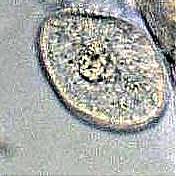ALL THINGS KOI
AND H2O
Chilodonella Cyprinii
(Chilodon)
By Duncan Griffiths
Chilodonella
is a common fresh water parasite with many genus spread across all corners of
the globe, with the best-known genus being C, Cyprinii.
In salt water fishes it has counter part
called Brookynella equally as deadly
Chilodonella
is classed as a motile ciliate protozoa that will graze on epithelial cells of
the gills and skin, described as heart shaped, but the best description of the
shape I ever read was "leaf" shaped for me this sums the description
up.
It
measures approximately 50
microns by 40microns and can easily be seen at x 150, although it is one of the
more tricky parasites to recognise, seeming to blend into its surroundings a
little morethan most parasites, although described as motile its movements are
not as rapid as most other parasites I.E. Trichodina or Costia but once you know
what it looks like in reality, it is easier to
spot.
Staining
a slide with Methylene blue may be of help if you have never seen this parasite
before.
Note:
Chilodonella leaves the host immediately after death of the host occurs, so you
will usually not find it upon examination of a dead fish
specimen


As mentioned its shape is
like a broad leaf with a little dimple in the posterior broader end. When viewed
under a microscope it's fairly transparent to an untrained eye. Chilodonella has
a nucleus in the lower third of the body with a micronucleus
inside.
It
is flat on the ventral side and convex on the dorsal
side.
The
cilia is on the under side with the top having no cilia at all. The mouth is
also on the ventral side with an oral groove
Chilodonella
reproduces by binary fission or occasionally they will join together to
reproduce this is called conjugation, where they may share genetics, as with a
lot of parasites Chilodonella can and will lie dormant until conditions become
favourable, I.E. the koi gets stressed with poor water conditions or some other
disease, then it becomes a serious adversary and mover, with an optimum
temperature range of between 5-10 deg c, giving them a significant head start on
the koi's immune system coming out of winter in early spring. When presented
with the right conditions and opportunity chilodonella can reproduce at an
alarming rate, and quickly over come a koi
Typically
it's not uncommon to find this parasite on a weak koi suffering from other
ailments, and as with Costia this would not be considered unusual thing to see
under a scope, but remedial, actions/treatments should be put in place as soon
as is possible to prevent any outbreak, but in heavy infestations it is
unmistakeable in the symptoms it presents.
Fish
begin to breath laboured become very lethargic, clamped fins and spend lots of
time at the surface gulping air, usually head up at the surface with the body
looking down into the pond at an odd angle with instability in there swimming
motion, you may even be able to push them over, and above all horrendous amounts
of thick mucus are produced, coupled with secondary bacterial infections in the
later stages of the disease.
It should also be noted if this
parasite gets a foothold some of the koi may not make it through any and all
treatments, as some koi will be severely weakened.
Treatments
are many but in the past I have found chilodonella more than able to resist
quite a few, in particular and surprisingly, Potassium Permanganate, successive
doses rendering no effective cure in lots of clinical cases, unless used in
conjunction with salt, but I must confess I'm not a huge fan of the using of
Potassium Permanganate with salt. Chilodonella may respond to PP used on its own
on the odd occasion. Chloramine T, Acriflavine and other chemicals also have
limited sporadic success
As
with white spot one treatment stands out head and shoulders above all
others:
Malachite
green and Formalin used simultaneously
I
have yet to hear of a case of chilodonella that has not to succumbed to this
treatment usually in single dose or two doses a week apart, so while other
medicines do have there success with this parasite, if you want to nail this
critter and nail it fast and get it every time, my personal choice would be
Malachite green and Formalin.